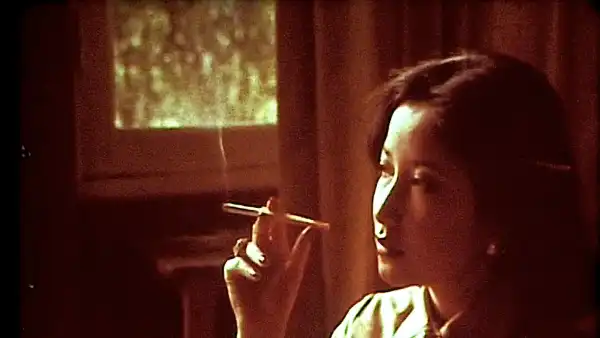
Save this storySave this storySave this storySave this story
While considering the selection within the New York Film Festival’s Revivals section—and, indeed, anytime I notice a significant retrospective headed to one of the city’s revival theaters—I view these showings not so much as preserving cinema’s past but, instead, as protecting its future. The critical aspect concerning this art form’s chronicle is its inventive capacity, its aptitude to ignite future generations of filmmakers and inspire upcoming movies. With this in mind, a key highlight of this year’s festival is the global debut of a restored version of Mary Stephen’s picture “Ombres de Soie” (“Shades of Silk”), originating from 1978.
“Shades of Silk” marked Stephen’s inaugural feature, and it endures as a striking demonstration of form, style, and historical insight. Around twenty-five when she crafted the movie, Stephen was born in Hong Kong to a Chinese family that relocated to Montreal in 1967. She produced a few short films in Canada and then, during the mid-seventies, secured a grant to study cinema in Paris, where she created “Shades.” The production budget was modest—it was filmed in 16-mm., with a limited crew and Stephen portraying one of the lead characters herself. However, the final product is quite different from the typical roughness found in independent filmmaking. In a concise sixty-two minutes filled with elegantly winding visuals and seductive surfaces, it presents a tale that encompasses continents and decades.
The story revolves around an unattainable romance, centering on two young Chinese ladies, close friends in Shanghai during the nineteen-twenties, whose bond has a potent erotic undercurrent that stretches into adulthood. In 1934, Lysanne (portrayed by Alexandria Brouwer) is residing in Paris and corresponds with her friend Marlène (played by Stephen), who is enrolled at Wellesley, urging her to transfer to a Parisian university. There are glimpses of their shared past, but Lysanne’s entreaties prove ineffective. Overcome with longing for Marlène, she suffers a mental breakdown and seeks refuge with her mother, who now dwells in French Indochina. Upon arrival, Lysanne weds a wealthy young man. Marlène receives an invitation to the wedding, attends, and maintains a composed facade for as long as she can, until the affable exterior crumbles, leading to devastating consequences.
A fundamental element of modern filmmaking is that, independent of so-called avant-garde cinema, it doesn’t shun narratives but openly showcases the means by which stories are conveyed—often through a boldly indirect or distant link between a story and the imagery and performances that conjure it. “Shades” starts with a quote extracted from Marguerite Duras’s script for Alain Resnais’s “Hiroshima Mon Amour” (1959), and Duras gradually materializes as an imposing influence over Stephen’s work. While renowned as a novelist, Duras rose to prominence as a filmmaker during the nineteen-seventies, and her 1975 movie “India Song” acted as Stephen’s primary source of inspiration for “Shades,” which is in clear conversation with the preceding film. Both share a portrayal of romance within colonial environments, ballroom-dance sequences, and a storyline presented mainly through voice-over narration—including, in “Shades,” the correspondences between the women and an all-knowing storyteller. Nevertheless, Stephen’s film, while appearing to partake of Duras’s realm, also re-imagines it. Duras was born in French Indochina, near present-day Ho Chi Minh City, in 1914, and spent much of her youth there, not relocating to France for good until 1933, to pursue university studies. Stephen—unlike Duras, whose family was white and from France—experienced the stresses of colonialism from the opposite perspective, as a Chinese individual subject to British authority. In “Shades,” the unease, the sense of a home that is only provisional, suggests the societal and political strains of living in a country that both is and isn’t one’s own—of navigating cultural hierarchies both overt and concealed and handling relationships (including romantic ones) with colonizers.
Stephen communicates life among the colonized not just through the narrative but also through the film’s structure. The unfolding is largely asynchronous, with the actions portrayed contrasting with the voice-over narratives, creating an effect that unsettles the movie’s present state, imbuing it with nostalgia and a yearning for potential futures. Stephen depicts the women’s school friendship through mesmerizing flashbacks, and their separation largely through its very absence, using gliding, reflective shots of locations—rooms, structures, streets—where the women have been and might return, but which, on screen, are empty. Despite filming in Paris with a very limited budget, Stephen pulls off a remarkable depiction of Asia and bygone eras. She even interweaves the story’s timeline with the time when she created the film: Lysanne’s wedding feast, displayed in dramatic fragments, is enhanced with a sequence of still images from a modern banquet that mirrors the one in the story while also extracting it from its imaginary context. There’s a sense of timelessness to “Shades”: it’s set in the mid-nineteen-thirties, it depicts the twenties, it was created in 1978; it blends stylistically with several masterpieces of its era but is so evocative of the past and so artistically and thematically innovative that it feels as though it exists outside chronology. The film appears somewhat displaced and remote from itself.
It makes sense that Stephen, as a filmmaker of absences, has enjoyed a noteworthy career as a film editor—most notably, on the movies of Éric Rohmer, with whom she briefly collaborated soon after producing “Shades,” and then consistently from 1991 until his final film, in 2007. Editors are the cinema’s eliminators, and they produce several kinds of absence: some deletions merely remove elements, whereas others give rise to, shaping the available material to conjure more powerfully what is missing. With “Shades,” Stephen broadens and amplifies the association of drama and form in ways that provide exemplary lessons for filmmakers today.
The showings of “Shades” at the New York Film Festival align with a retrospective of Stephen’s oeuvre at Metrograph. Besides “Shades” and some of her short films, it encompasses her impressive recent feature, “Palimpsest: The Story of a Name.” The film is a personal documentary structured as a quest to ascertain how Stephen, despite being Chinese, acquired an English family name. It is centered on her departed parents, Henry and Hilda Stephen, and tracks the complex journeys that marked their lives. They encountered each other in Hong Kong, but Henry wasn’t native to the region, and their peripatetic life mirrored an era of political turmoil in Asia, including Japan’s military conquests during the nineteen-thirties and its occupation of Hong Kong during the Second World War. Stephen’s parents, who were entrepreneurs, seem to have inspired the filmmaker’s talents through their pursuits: Hilda was a published poet, and Henry was an amateur filmmaker who left an extensive archive of home movies and a remarkably substantial collection of autobiographical writings and family records. Stephen’s narrative style here is as elaborately detailed and remarkably creative and layered as it is in “Shades of Silk,” while also being witty and lighthearted, conveying the warmth and occasional eccentricity of family bonds alongside the inventive implications of family history. I appreciate that “Palimpsest” is being showcased at Metrograph, but I wish it enjoyed the more prominent stage of the N.Y.F.F. I’ve watched numerous fine new films at the festival, and Stephen’s recent one is on par with them.
Another N.Y.F.F. revival, “The Wife of Seisaku,” from 1965, vividly and intimately portrays a significant chapter in history. The director is Yasuzô Masumura, whose films—such as “Giants and Toys,” “Black Test Car,” and “Red Angel”—rank among the gems of Japanese cinema. Masumura’s professional life was extensive, encompassing roughly sixty films released between 1957 and his passing, in 1986, at the age of sixty-two. However, only a handful of his movies are accessible in the U.S., and the restored version of “The Wife of Seisaku” serves as a superb introduction to his biting body of work. It is set in a remote Japanese village circa the time of the Russo-Japanese War of 1904-05. A woman named Okane (Ayako Wakao) comes back to the village, having been the mistress of a prosperous businessman who passed away unexpectedly, leaving her a considerable inheritance. She lodges with her mother and accommodates her feckless brother but is reviled and isolated by the rest of the villagers because of her past. Subsequently, a young man by the name of Seisaku (Takahiro Tamura), who has been serving in the military, returns to the village, where his sweetheart, Oshina (Yuka Konno), awaits him. He arrives brimming with patriotic fervor, keenly instilling martial pride among the villagers, yet he has little patience for their treatment of Okane. His compassion for her soon transforms into love, and he defies the community to take her as his wife. However, war erupts, and he’s conscripted back into service. Okane is anguished at the prospect of losing both her true affection and her lone advocate, and her desperation precipitates extravagant and devastating drama.
Masumura is a trenchant critic of Japanese nationalism and militarism, mocking their grandiosity and conceit and disparaging what he perceives as the constricting moralism of his nation’s tradition-bound social framework. In this regard, his output mirrors that of elder directors such as Kenji Mizoguchi and Yasujiro Ozu. Yet Masumura’s approach is stark and severe, a cinematic counterpart to pulp fiction, featuring intense emotional and physical acts of violence, frank and heated eroticism, frantic performances, and garishly distorted visual arrangements. (His nearest Hollywood equivalent would be Robert Aldrich, most celebrated for such frenzied movies as “Kiss Me Deadly” and “What Ever Happened to Baby Jane?”) “The Wife of Seisaku” is shot in black-and-white wide-screen format, and its unbalanced visuals and misshaping angles suit Masumura’s raging, cynical, yet intensely open-minded perspective, and his demystification of the revered legends of history. ♦
Sourse: newyorker.com






